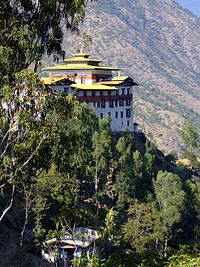Trashigang District
27°15′N 91°40′E / 27.250°N 91.667°E
Trashigang district
བཀྲ་ཤིས་སྒང་རྫོང་ཁག | |
|---|---|
District | |
dzongkhag (district).
CultureThe population of the district is mainly Sharchop, which means "easterner" in Dzongkha , the national language.
LanguagesThe dominant language of Trashigang is Dakpa language and the Southern Bodish Brokpa language. Dakpa is spoken by descendants of yakherding communities, and may in fact be a divergent dialect of Brokpake, heavily influenced by Dzalakha.[2][3]
Economy and educationWhile it has no major urban area, Trashigang has the densest population in Bhutan. It used to be part of an important trade route connecting lavender .
There are several tourist packages to Bhutan that include trips from Thimphu to Trashigang, despite the 17-hour journey from the capital over the rough and dangerous Lateral Road. Trashigang is also the site of Sherubtse College, the original college within the Royal University of Bhutan system. Landmarks Trashigang Dzong, or fortress, was built in 1659 by the third Druk Desi Chögyal Mingyur Tenpa to defend against Tibetan invaders. Because of its altitude, invading armies remarked that "it is not a dzong on the ground, it is in the sky". An ancient Shantarakshita and Chögyal Trisong Detsen (Khen-Lop-Chö sum).
Administrative divisionsTrashigang Districts is divided into fifteen village blocks (or
Protected areaThe Khaling Wildlife Sanctuary in Samdrup Jongkhar District to the south.[6]
See alsoReferences
External links |
